�

�
Classic Choice
�MGB GT V8
�� Scarcely a sales success, nonetheless the Rover V8-powered MGB GT V8 was and is a pleasant� performance package. Graham Robson unfolds its development history and tells you what to � look out for when buying one.�
��
as published in BritishV8 Magazine, Volume XVII Issue 1, July 2009�
�
Re-printed unedited by exclusive written permission of "Thoroughbred and Classic Cars".
�
This article originally appeared in their December 1982 issue.�
�
�
The MGB GT V8 was a fine car - fast, elegant, long-legged, and mechanically �
simple - but there was always one abiding problem. It didn't sell. British �
Leyland launched it with high hopes in 1973, and dropped it without fanfare �
in the autumn of 1976. Hailed as an instant classic when it was new, the V8 �
then took time actually to earn that reputation all over again. �
�
Even so, this smart fastback coupe had almost everything a lover of classic �
cars would want, including the fact that it was relatively rare (only 2591 �
were ever built) and that parts, interchangeability, and the existence of �
service expertise were all available. Many of these cars still exist, there �
is a thriving MG club to look after their interests - and they don't make �
them like that anymore. So, how does the car stand up to inspection today? �
The Solihull connection
��
The real start of this story dates from 1962, when the MGB was announced or, �
more accurately, from 1965, when the sleek fastback hatchback coupe version, �
the MGB GT, was put on the market. No-one surely, needs to be told that the �
MGB family was built continuously until 1980, and that more than half a �
million of all types were built. Nor, I am afraid, will they need to be �
reminded that Abingdon production closed down with the last of the MGBs, �
that the site was then sold off, and that the buildings have now been demolished. �
�
Right from the start, MG management detected a demand for more powerful versions �
of the MGB. The basic chassis, and the handling, were so good, that much more �
power and performance could be absorbed without ruining the balance. Their �
first solution, and one which was also intended to displace the ageing Big �
Healey as well, was to produce the six-cylinder MGC in roadster and GT forms. �
Between 1967 and 1969, 8999 MGCs were built; at the time, such sales and the �
behavior of the car were maligned, but calm analysis of its success in a small �
market sector shows that it sold remarkably well. However, it was never �
profitable to BMC/British Leyland, because it had a unique type of torsion �
bar front suspension and a very different front structure from that of the �
MGB. We can thank the MGC, however, for the development of the stronger �
all-synchromesh gearbox and the Salisbury axle, which were so valuable to �
later derivatives. �
�
Following the limited success of Ken Costello in selling converted MGBs with �
Rover V8 power, MG tried again. By mid-1973 they were ready to launch a new �
super-fast MGB derivative with more power than ever the MGC had (in spite of �
the figures that were published!), and with many fewer different and unique �
parts. In effect, therefore, the MGB GT V8 was an MGB GT with an engine �
transplant - the old BMC B-series unit had been discarded, and it its place �
was the splendid light-alloy Rover 3.5-litre V8 unit. 95bhp gave way to 137bhp, �
and the performance of the car was transformed. �
�
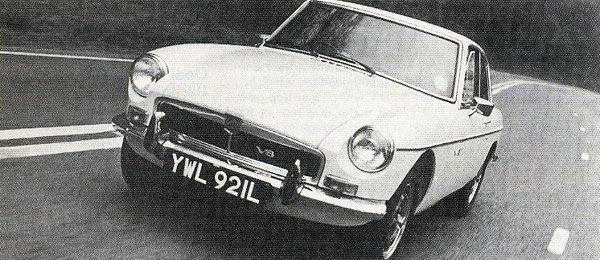 �
�
Mechanical layout
��
The car was amazingly like the original Mk II MGB GT in all important respects, �
except for the different engine. Whereas with the MGC at least 30 to 50 percent �
of the body structure had been changed to accommodate the new engine and front �
suspension, for the MGB GT V8 changes were positively minimal. �
�
For a start, I must make one thing clear - MG never sold an open version of �
the car. I know that a handful of cars have been "created" - either by the �
successors to the Costello business or by private owners - but each and every �
factory-produced MGB V8 was a GT, with the coupe body style. The reasons for �
this were several and various - I discount the suggestion that the open body �
was not strong enough to withstand V8 torque and power, but I do believe the �
theory that very fast open cars do not sell in economically large numbers anymore. �
�
The basic bodyshell and chassis therefore was the same as that of the �
MGB GT. Sheet metal differences were confined to different panels in or �
near the engine bay - notably the inner wheel arches, toeboards, chassis �
side members, and oil cooler support platform - while the whole shell was �
lifted further off the ground to satisfy impending USA regulations (though �
the car never went on sale in the USA!) The overall styling, seating �
arrangements (including +0 rear seats!), lift-up hatchback, instrument �
layout (but not the instruments) and the fittings were the same as the �
MGB GT which is a help when it comes to spares interchangeability. �
�
The engine was basically that of the Rover P5B saloon/coupe, which special �
inlet and exhaust manifolding by MG, and with twin SU carbs mounted at the �
rear of the manifold, close to the passenger bulkhead. However, for space �
reasons, there were two thermostatically-controlled electric fans mounted �
ahead of the radiator block. �
�
Apart from the special casing, to mate up with the V8 engine, and the use �
of different constant-mesh (input) gears, the gearbox was mainly that of �
the existing MGB, while the back axle was also the same except for the use �
of a high (3.07:1) final drive ratio which had already been used on some �
derivatives of the obsolete MGC. Overdrive was standard, but it only operated �
on top gear, and there were no other transmission options - no V8 car was �
ever sold with automatic transmission.�
�
The basic suspension layout, except for different front and rear springs was �
exactly the same as that of the MGB, as was the Lockheed braking system. The �
wheels were very decorative Dunlop items, with cast alloy centres riveted �
to steel rims. They were similar to, but not the same, as those fitted to �
the Costello V8s, and to some Reliant Scimitar GTEs.�
�
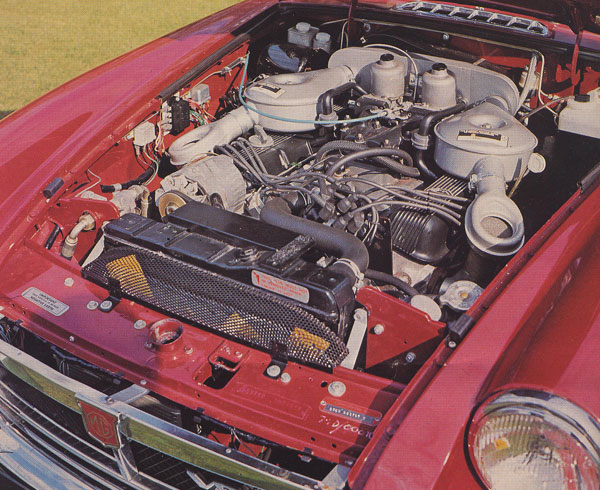
�
Above, a fairly tight squeeze to shoehorn Rover's V8 into the MGB bay - but it fits!�
MGB GT V8 evolution
��
Sales began in August 1973, from Chassis Number 101, and carried on in original �
form to Chassis Number 1956. From October 1974, at Chassis Number 2101, cars �
began to be built with the massive crash-test black bumpers, a change which �
also meant the use of different front and rear body sheet metal behind those �
bumpers. The last 1975 model year car was Chassis Number 2632, but the first �
1976 model-year car was Chassis Number 2701. The last car of all, built in �
September 1976, was Chassis Number 2903.�
�
It is important to realise, therefore, that Chassis Numbers 1957 to 2100, and �
2633 to 2700 do not exist - so if you are tempted to buy a car with one of �
those numbers, it a certainly a fake!�
�
Just one car, we understand, was built as an Anniversary Special in 1975 �
(green with gold striping)l but there were no 'Special editions' of any type �
and the last car of all is owned by BL Heritage.�
Maintenance and restoration
��
Apart from one well-known problem (the longevity of the hard-worked gearbox) �
there is little to stop an enthusiast from buying and enjoying an MGB GT V8 �
except finding one. When I researched these cars in detail n 1981, I was �
told that an estimated 1700 still exist, but I was also told that their �
worth is now recognised and that the market is very thin. Be prepared �
therefore, to have to look around for some time to find the car you need - �
at least your choice will not be too confusing for all have the coupe body, �
and all have manual plus overdrive transmission.�
�
There are around 1500 ex-MGB dealers in the UK, but all current BL dealers of �
whatever persuasion can plug in spares requests to Unipart. This organisation �
still has a large stock of MGB GT V8 parts, though special items like engine �
castings and road wheels are already out of stock, while some soft trim items �
(seats, carpets, trim panels) may also be difficult to find.�
�
There is a massive Parts List for all MGBs which, if you can wade through it, �
contains everything you need to know about the GT V8. If you don't inherit �
literature with your car when bought, then one of the MG clubs (of which you �
surely ought to be a member) can certainly help. Unfortunately there is no �
Haynes Workshop Manual to cover these cars.�
�
However, there are good V8s and bad V8s. Like most cars, they are by no means �
perfect, so if you are shopping around for one of these fast and refined �
machines, here s what to look for.�
| �
Enjoying this article? Our magazine is funded through the generous support of readers like you! � To contribute to our operating budget, please click here and follow the instructions. � (Suggested contribution is twenty bucks per year. Feel free to give more!)� |
Bodyshell
� �
Fortunately, the MGB was very rugged right from the start, and the GT body �
handles V8 power with aplomb. After all, a car that can approach 125mph and �
rush up to 100mph in about 20 seconds needs a stable platform which will not �
deteriorate with age. V8 cars however are no better or worse than the �
mass-produced MGBs.�
�
The structural problems may eventually appear to the silI and outer sill areas �
inside the front wheel arches at the mud traps near the junction with the front �
toe-boards and along the top of the front wings. Rust will also tend to appear �
where the rear wheel arch meets the rear wing itself, and along the edge of the �
wheel arch cut outs. Doors, too, tend to get rusty edges particularly at the �
bottom and there may now be corrosion at panel joints around the massive black �
plastic bumpers. The worst possible problem however is that water leaks or �
sheer bad luck may have affected the floor of the car itself. MoT failure �
points are of course, the sills and any structural defects around the main �
chassis.�
�
Incidentally, there should be no question of water leaking around the aperture �
of the hatchback - if there is water ingress, this is almost certainly due to �
faulty seals or (bad news, this) that the car has at one time been inverted, �
and badly repaired or renovated afterwards. I don't have to tell you, I hope, �
to look for any signs of accident repairs in terms of different colour paint �
patches, or anything untoward about the underside of the car, particularly �
near the "corners". �
�
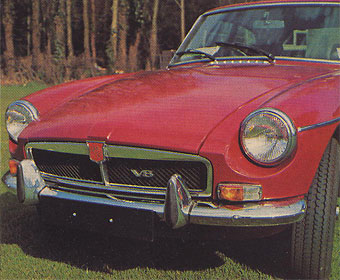 �
�
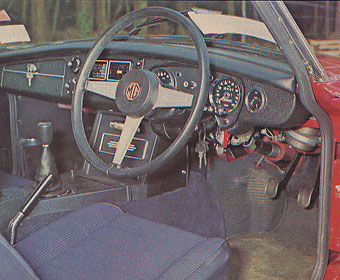
�
(left) We think the pre-plastic front bumper models look best.
�
(right) Instruments differ from MGB but arrangement the same.�
Suspension and steering
��
It's a very ordinary front suspension set-up, I'm afraid, which means that �
bushes and trunnions all tend to wear out. Look at the trunnions and king-pins �
in particular (apart from being an MoT failure area, these may accelerate �
tyre wear if worn), but check all wishbone bushes as well. Fortunately �
replacements are cheap and not too difficult to change over. The lever-arm �
dampers, incidentally, also make up the upper wishbone linkage, so check not �
only that they are not worn full and not leaking oil, but that their mounting �
to the crossmember is secure, for this is another possible corrosion point. �
�
The steering should be light, and should not feel "gritty". The V8 engine is �
virtually no heavier than the B-series four cylinder it displaced, so the �
steering should not require strong muscles. Be sure that it is not rattlely �
as well - stresses on the teeth are quite high in such an installation - and �
that there are has been no accident damage to the mountings. Ball joints wear, �
too, but you should be able to spot these in a ramp inspection. �
�
Be sure that those expensive and rather exclusive wheels are in good condition. �
A special tip is to insist on seeing a spare wheel - we have heard of cases �
where it was not of the same type as the other four! These wheels are no longer �
available as new spares, so you can't afford to buy a V8 with one faulty wheel, �
can you? �
Engines, transmissions, brakes
��
The V8 Rover-built engine is a large under-stressed unit, which therefore has �
an easy time in the MG. However, I hope the engine oil has always been changed �
regularly because the hydraulic tappets will suffer if not. Signs of wear come �
in the valve gear and rocker shafts, which you should also look for signs of �
timing chain stretch. Because the carbs are parallel, and close together, it �
is easy enough to make sure they are in tune and stay in tune. There should �
be no excuse for slack fan belts, or for distributor settings being neglected, �
for both are easily accessible under the well filled bonnet unlike many �
comparable large-engined cars. �
�
The significant transmission problem is the gearbox, which is only just up to �
its job. You can't get complete new transmissions any more, thought I believe �
overdrives are available. If a V8 has been used hard, the input or constant-mesh �
gears eventually suffer, and it's not unknown for teeth to be stripped - so �
beware noisy or rough gearboxes - there may be a potential expensive problem. �
Sluggish overdrive operation, however, is likely to be due to faulty solenoid �
electrics, rather than an internal problem. The back axle is fine, which is �
probably just as well (the only other MG to use 3.07:1 was the 1968 �
non-overdrive MGC) - but it may be a bit loose and clonky, for which there is �
no easy solution. �
�
Even though the brakes are pure MGB four cylinder, they are well up to the �
job. After all, the V8's no heavier than the four cylinder car - it is merely �
that it often has to be stopped from rather higher speeds. Compared with �
similar fast cars (3.0-litre Capri or Reliant Scimitar, for instance) the V8 �
is certainly not under braked. �
Interiors and decoration
��
One of the reasons that the MGB GT V8 didn't sell all that well was that it �
looked almost exactly Ike the same four-cylinder MGB, and many other MGBs that �
had gone before. But that makes easier to find parts when you need them for �
restoration. Externally the only V8 differences are that there are the special �
road wheels, and V8 badges on the grille and the passenger-side front wing. �
We've seen some ordinary MGBs, incidentally with V8 badges fitted!�
�
Parts for the interior are becoming difficult to find, particularly on the �
earlier examples, and I'm afraid that the carpet and seat cover standards �
were only those of the 1.8-Iitre four-cylinder car. Quite a proportion of �
the remaining V8s were casually mistreated by their second or third owners, �
so don't expect miracles when shopping around.�
�
However, if Unipart cannot supply trim and decoration, suppliers approved by �
the MG Owners Club usually can, as re-manufactures for the four cylinder cars �
is now a thriving and expanding business. �
�
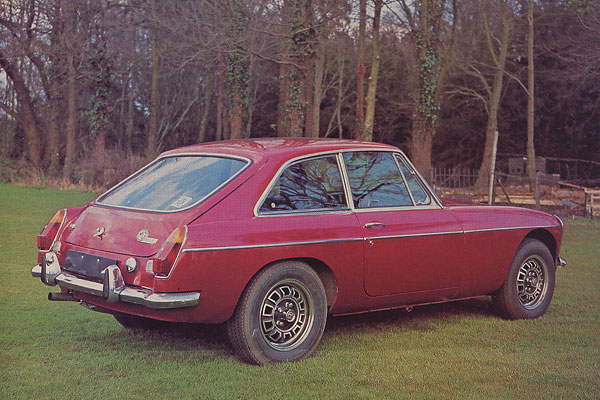
�
Smart wheels are a MGB GT V8 distinquishing feature.�
Experts
��
I'm sure Peter Laidler will not mind being named as the MGB GT V8 expert, as �
he owns such a car, and regularly writes on V8 technical matters for MG club �
magazines. You find him at:�
�
Peter Laidler,
�
Howard Cornish Road,
�
Marcham, OXON. �
Interchangeability
��
Although the MGB GT V8 has been out ot production for more than six years, �
most parts are still available from Unipart. However, the following hints �
may help you fill the gaps.�
�
Bodyshells are almost identical with four cylinder MGB GTs except where �
noted in the text.�
�
Front and rear suspensions, apart from spring settings, were the same as �
four cylinder MGB GT.�
�
Wheels were unique, but their centres were the same as those used on Reliant �
Scimitars of the period (but not the rims). �
�
Engines were broadly the same as Rover V8s fitted to other cars - with low �
compression Range Rover pistons, and P5B saloon coupe details in some other �
respects.�
�
Gearboxes had a unique casing, but some internals were the same a four �
cylinder MGBs in some respects. �
�
Axles were the same as fitted to MGBs of the period, except for the final �
drive ratio, which is shared with some MGCs.�
Spares, Clubs, Values
��
Many parts common to four-cylinder MGBs and MGB GTs are of course still �
available, but supplies of special-to-V8 items, whether engine castings, �
body sheet metal, or soft trim - are running down fast. Our advice is that �
you should first look for parts at your nearest reliable MG/BL dealer, but �
to ask for parts by a known part number, rather than by the name of the �
MGB GT V8. (Some dealers, we regret to say, are more helpful than others!) �
�
There are, however two excellent clubs - the MG Owners Club and the MG Car �
Club, both of which are large organisations with good networks of approved �
dealers and specialist suppliers. Your contacts therefore should be:�
| MG Owners Club | MG Car Club | ||
| 13 Church End. | 67 Wide Bargate | ||
| Over. | Boston, | ||
| Cambridgeshire, | Lincs, PE21 6LE | ||
| Tel: 0954 31125 | Tel: 0205 64301 | ||
� The value of MGB GT V8s has been somewhat depressed by the stigma of the � large-capacity engine, but raised by scarcity value. Many of the cars � survive, and a most all of them are still in the UK. We think you may � have to pay about 1500 for a scruffy 1973 example which is, after all, � nearly ten years old and may be rust-bitten), but for a really good late-model � car (preferably without black bumpers) you might have to pay up to 4000. We � doubt if any MG MGB GT V8 is worth more than that, unless it is concours and � intended for showing. �
��
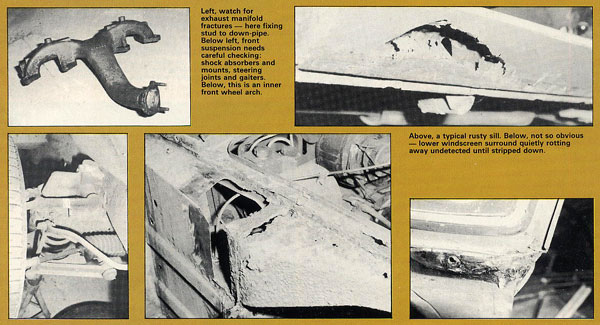
�
Buying an MGB GT V8: potential problems to look out for.�
Specification
��
Engine: Overhead valve 90 degree V8 cylinder, with five bearing crankshaft, �
in light-alloy cylinder block. Valves operated by pushrods and rockers from �
camshaft mounted in vee of cylinder block; hydraulic tappets. Light alloy �
cylinder heads, two valve per cylinder, and two SU carburetors. Bore and �
stroke 88.9 x 71.1 mm, 3528cc. 137bhp (DIN) at 5000rpm. Peak torque 193lb.ft. �
at 2900 rpm. �
�
Transmission: Four speed all-synchromesh manual gearbox, with remote control �
change. Plus Laycock overdrive operating on top gear only. No transmission �
options. Hypoid bevel final drive 3.07:1 final drive ratio.�
�
Suspension: Independent front coil springs, wishbones, anti-roll bar, lever �
arm dampers, live rear axle, suspension by half-elliptic leaf springs, and �
lever arm dampers. �
�
Steering: Rack and pinion, no power assistance.�
�
Brakes: Lockheed hydraulic, disc front and drum rear, with vacuum servo �
assistance.�
�
Wheels: Cast light/alloy centres with steel rims, four stud fixing, and 5.0in �
rims. 175HR14in radial ply tyres.�
�
Bodywork: Unit construction pressed steel body / chassis unit, in two door �
fastback coupe style, with large upward opening hatchback, all right-hand �
drive except seven pre-production cars. No alternative styles. No open derivative �
available. Length (to chassis no. 1956) 12ft 10.7in. (from chassis no 2101) �
13ft 2.25in. Unladen weight 2442 lb.�
�
Performance: Maximum speed 124mph (in overdrive top); 0-60mph 8.6sec, 30-50mph �
in direct top 6.5sec, 50-70mph in direct top 6.8sec; 70-90mph in direct top �
8.3sec; fuel consumption 23.4mpg.�
�
Production: 2584 with right-hand-drive, seven with left-hand-drive.�
| Annual production: | |||
| 1972 | 3 | ||
| 1973 | 1069 | ||
| 1974 | 854 | ||
| 1975 | 489 | ||
| 1976 | 176 | ||
� From 1973 to October 1974, 1856 cars were built to "chrome bumper" specification. � From October 1974 to September 1976, 735 cars were built to "black bumper" specification. �
��
� BritishV8 Magazine has assembled the largest, most authoritative collection of MG � "MGB GT V8" information you'll find anywhere. Check it out! � Access our � MGB GT V8 article index by clicking here. �
�
